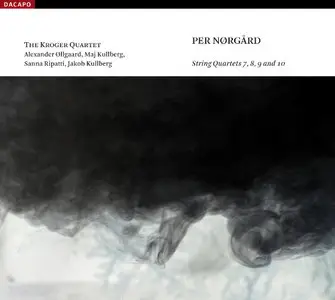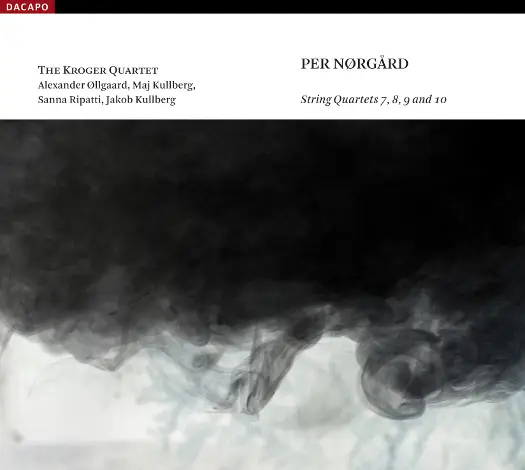Per Nørgård - String Quartets 7-10
FLAC + CUE + Cover, No Log | 302 MB | RS
Label: Dacapo | Catalog: 8.226059 | Year: 2008
The musicians can play each in their own keys or their own rhythms, but for the listener who encounters the totality what is manifested is a quivering figure, an oscillating but quite clear gesture, in descending or ascending motion or arches. - Liner notes
I think you all know by now that I am a Nørgård fan, so here is another fantastic recording of his later string quartets.
Tracklist:
1. String Quartet No. 7: 1. Andante - Allegro impetuoso
2. String Quartet No. 7: 2. Lentissimo, quasi non misurato
3. String Quartet No. 7: 3. Allegro con brio
4. String Quartet No. 8, 'Night Decending': 1. Prologue - Eulogy
5. String Quartet No. 8, 'Night Decending': 2. Man - Animal
6. String Quartet No. 8, 'Night Decending': 3. Voyage
7. String Quartet No. 8, 'Night Decending': 4. Night Descending
8. String Quartet No. 8, 'Night Decending': 5. Epilogue - Elegy
9. String Quartet No. 9, 'Into the Source': 1. Allegro energico
10. String Quartet No. 9, 'Into the Source': 2. Calmo
11. String Quartet No. 9, 'Into the Source': 3. Lento - Allegro brutale
12. String Quartet No. 10 ('Høsttidløs')
Performers:
The Kroger Quartet consists of Alexander Øllgaard and Maj Kullberg on violins, Sanna Ripatti on viola and Jakob Kullberg on cello. The four musicians are internationally trained, and as an ensemble have been taught by Tim Frederiksen in Copenhagen and David Takeno in London. The Kroger Quartet has also attended masterclasses with members of the Alban Berg Quartet, the Tokyo Quartet, the Amadeus Quartet and the Chilingirian Quartet.
String Quartet no. 7 was composed to celebrate the bicentenary of the Danish Royal Library as a national public library in 1993. The work has been revised several times since, and in its final form has been dedicated to the Kroger Quartet.
The first movement begins with faraway Nørgårdian signal notes, after which the movement surges into highly distinctive, fast, continuous motion at several levels. This motion carries everything along with it, and several times runs into something that recalls a waltz. Along the way one is swept for brief moments into very fast, mysterious passages where the quartet is a hive of activity, but which begin pianissimo. The first such place is characterized by runs and full parallel fifths that rise from pp to ff within four bars. Above the second such place we read Presto misterioso. Here there are bars where one musician plays 10, another 9 and the third 8 equally long notes in one bar, while the fourth voice enters after half a bar with its own staggered rhythms of 9 notes over two half bars. At that point the composer has written Wie ein Hauch, "like a breath"; the same thing is written at the last bar of Schoenberg's Six Little Piano Pieces from 1911. Here the strings are to play spiccato, sub ponticello, that is with a bouncing bow, close to the bridge which holds the strings in tension.
The slow second movement expounds brand new possibilities in a mode of writing that uses microtones. It begins with a chord that consists of a fifth plus a minor third raised a quarter tone, in other words a note and a chord that lie midway between major and minor. Above this, an alternative tonality complex is formed: the result is that throughout the movement there is an altern-ation between two diatonic systems, separated by quarter-tone intervals like sealed-off compartments.
The third and last movement forms the above-mentioned arch shapes in several layers, diatonically and at a brisk tempo: Allegro con brio. Here, as in other places in the quartets - in the actual attitude as it develops, not in the tonal material - there are reminiscences that go all the way back to the string quartet that helped to make Per Nørgård's name in earnest, String Quartet no. 2. Quartetto Brioso (1954, 1958).
String Quartet no. 8 in five movements is from 1995-97 and is based on material from Per Nørgård's chamber opera Nuit des Hommes (Night of Mankind - Night of Men). The text is by Guillaume Apollinaire and the action takes place before and during World War I. The quartet is entitled Natten sænker sig som røg - Night Descending like Smoke. In the first movement, Prologue - Eulogy we encounter a shimmering tissue of microtones and then an assemblage of fragments and inversions of the hymn tune Nu bede vi den helligånd (Now pray we to the Holy Ghost). This is in turn superseded by a section with repetitions of chords that spread out in freely chosen tempi to all the different instruments in polyrhythmic heterophony.
The second movement has the title Man - Animal, a grim, rhythmically insistent movement. The third movement, Voyage, begins with descending, sliding figures in several dimensions. It settles down to a middle register that sometimes has the feel of a distorted version of Nørgård's own infinity series. After this the movement spreads out again in quick, dot-like single notes, and train rhythms and drum associations combine travel and battle motifs.
The fourth movement, Night Descending, then begins in rather the same way as the third movement, but quietly and in a very slow tempo. Per Nørgård himself regards the boundary between the third and fourth movement as the contrast between enthusiasm for the new age when the war breaks out in the third movement, and in the fourth movement the very quiet, but all the more insistent existential Angst that is the result. The fifth and last movement, Epilogue - Elegy, returns to the motifs of the introduction, including the chorale, but now transformed or distorted into a lament, also with reminiscences of some of the other movements. The quartet moves directly in the frantic mode, while the drama of the other quartets is more associated with special musical elements, in Quartet no. 9 particularly rhythm:
String Quartet no. 9 was written for the famous Santa Fe Chamber Music Festival in the USA in 2001. It is in three movements, and the work has a title that is extremely noteworthy and helps us to understand this rhythmically direct yet complex work. The title is Ind i kilden (which can mean Into the Source or Into the Spring); in other words a reversed direction that is different from the spring's own, a motion back towards the origin and source. Even the association with which it should all begin, that is the spring or source itself, is actually only revealed in the last bars. The idea is ‘the further forward, the further backward', just as astronomers say that at some point in the future we shall be able to look even further back into the history of the universe. Per Nørgård writes that the quartet constantly digs deeper and deeper back towards the source, so that it approaches "the primal matter of music."
The three movements are fast - slow - fast: Allegro energico, Calmo and Lento-alle-gro ("brutale"). This directly accessible and particularly gestural work needs few words; the most important thing, also in a comparison with Bartók's quartets, is to point to the actual framework: that what may sound like a direct linear progression at the same time reflects the opposite. Just as we can say that time both goes and comes.
String Quartet no. 10. The title is Høsttidløs, actually the name of a plant (‘meadow saffron' or ‘naked lady'), but the name literally means ‘Harvest-Timeless' in English. It is a plant of the Colchicum family which flowers in September-October, while the leaves and fruit only appear in the spring.
The work was written with direct inspiration from the Kroger Quartet, alongside solo works for the quartet's cellist Jakob Kullberg. It also has stylistic affinities with the Harp Concerto from 2002, Through Thorns. The collaboration with a new generation of young musicians has undoubtedly contributed to the special lyrical and melodic transparency that is characteristic of the work. Here Per Nørgård pointedly revives the particular tonality he used in works in the 1970s. One can hear it right away: while the other three strings enter with muted tonal chords, in the cello we hear a kind of leitmotif of the work: three descending pizzicato notes. One imagines connoisseurs of Per Nørgård's music, when they hear just these three notes, nodding to one another: this is classic Nørgård, you can hear it in the course of just three notes. They are notes from the minor-like undertone or subharmonic series that Per Nørgård views as equal to the major-like harmonic or overtone series. One could say that they make up a C minor sixth chord, but they are also the second, third and fifth undertone if you start from the top on a G. This undertone series would also take in the seventh and create the so-called subdominant minor with an added sixth. The chord is common in popular music, although one does not hear it here. But it should be mentioned to emphasize that the use of the undertone series involves material with a strong emotional appeal. It is this that is emancipated from any sentimentality and introduced in new contexts.
The piece moves in one long breath through various landscapes, using the techniques and possibilities one also finds in the other quartets. There is a beauty, serenity and translucency in this quartet, where the concurrently and recurrently flowing melodies relate to the particular sense of temporality that comes from the repetition of the motif with its pizzicato notes several times along the way. It has not earlier seemed appropriate to mention Mozart's music in direct connection with Per Nørgård's music, but here we have it now: a new Mozartean transparency, a complete convergence of ‘classical' and ‘modern'.



